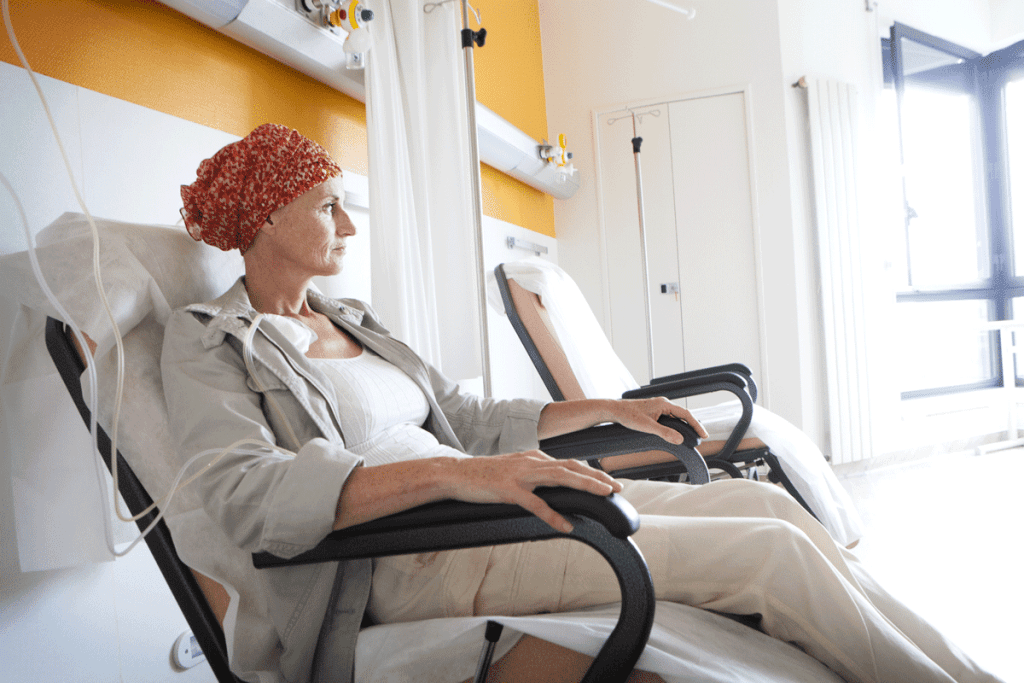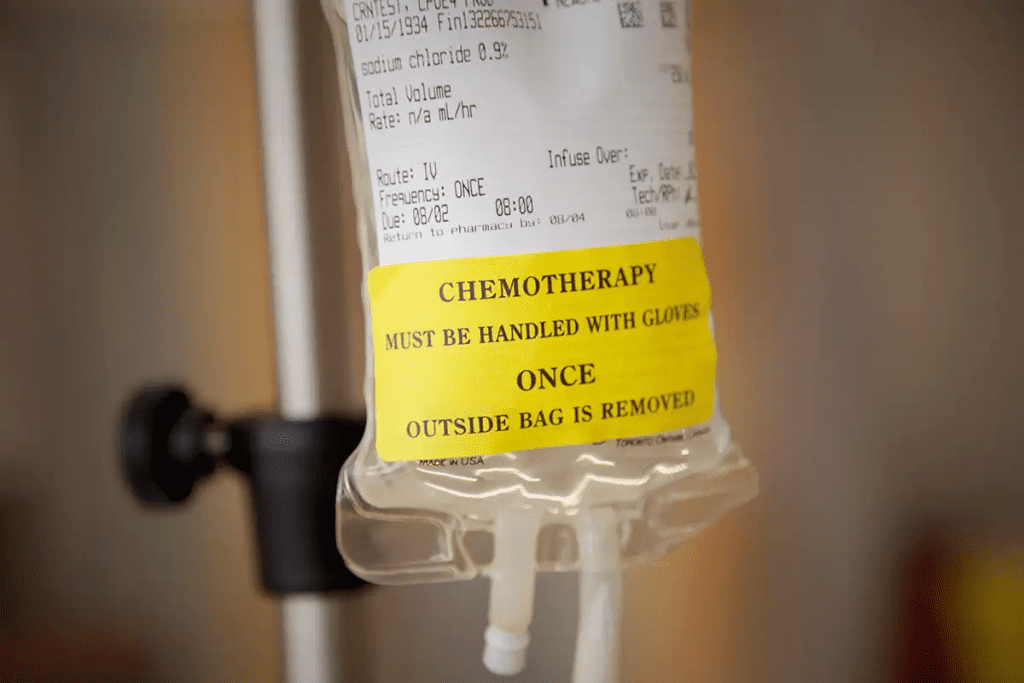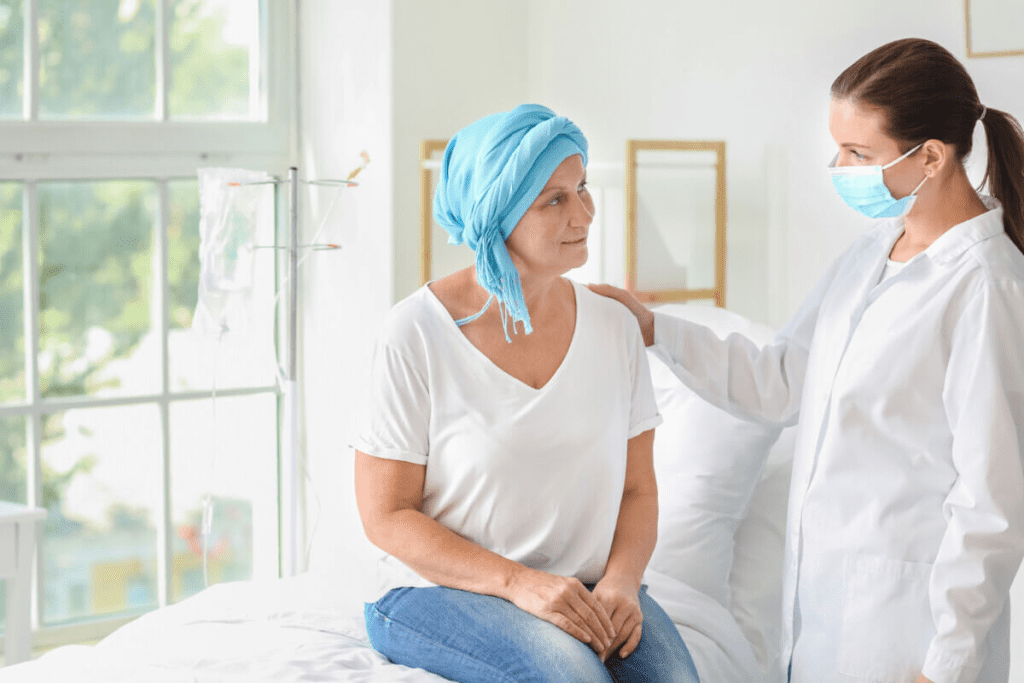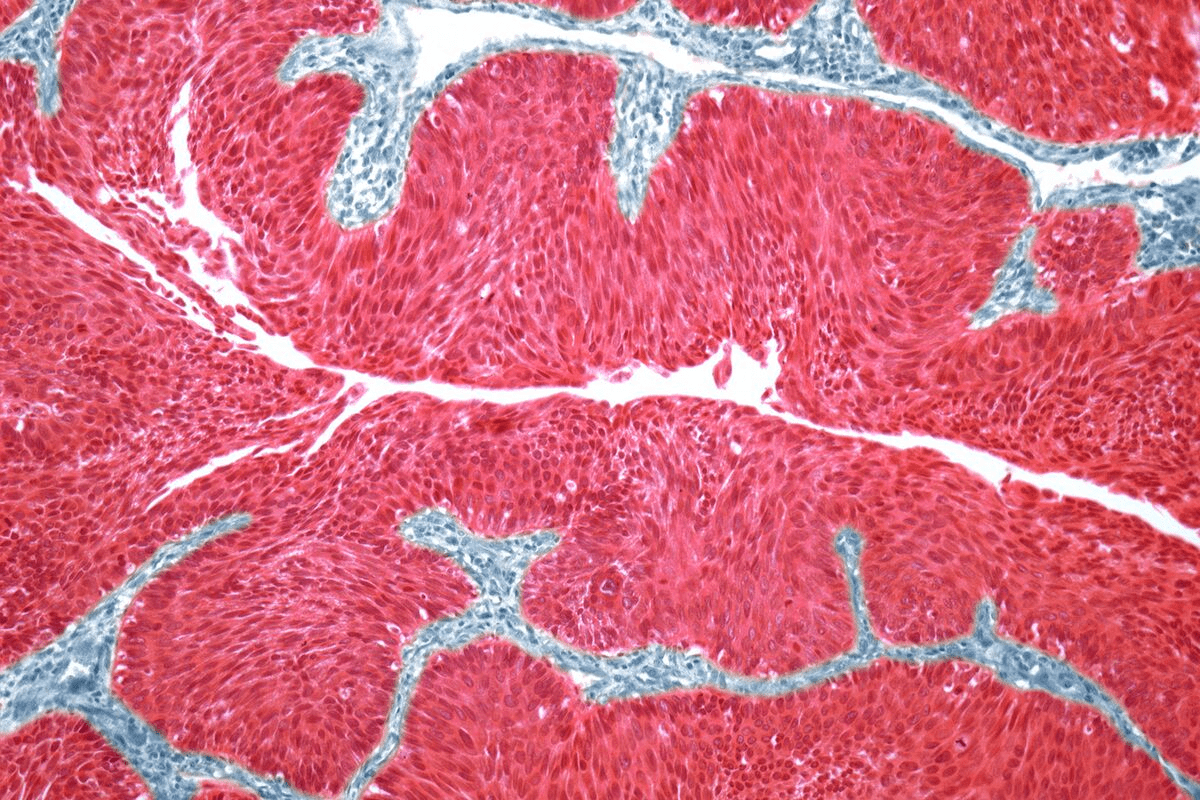Last Updated on November 26, 2025 by Bilal Hasdemir

Chemotherapy Precautions
When someone is on chemotherapy, it’s key to keep everyone safe. This includes making sure the bathroom is a safe space.
Chemotherapy drugs are dangerous if they touch bodily fluids. So, it’s not a good idea to share a bathroom with someone on chemo. The risk of getting exposed to these drugs is too high.
To stay safe, we need to take some precautions. Knowing what steps to take helps make a safer place for everyone.
Key Takeaways
- Chemotherapy drugs can be hazardous to others through bodily fluids.
- Sharing a bathroom with someone on chemo is not recommended.
- Taking precautions can minimize exposure risks.
- Safety measures are crucial for the patient’s well-being and others.
- Understanding necessary precautions can create a safer environment.
Understanding Chemotherapy and Its Effects
To understand the precautions needed during chemotherapy, we must first know how it works. Chemotherapy uses drugs to kill cancer cells. But, these drugs can also harm healthy cells, causing side effects.
How Chemotherapy Drugs Work in the Body
Chemotherapy drugs target cells that grow fast, like most cancer cells. The effects of chemotherapy can be far-reaching, impacting not just the cancer cells but also other rapidly dividing cells in the body, such as hair follicles and the lining of the digestive tract. This can lead to common side effects like hair loss and nausea.
Common Types of Chemotherapy Treatments
There are several types of chemotherapy treatments, each with its own set of drugs and application. Some of the most common include:
- Alkylating agents, which damage the DNA of cancer cells to prevent them from reproducing.
- Antimetabolites, which interfere with the production of DNA and RNA.
- Anthracyclines, a type of antibiotic that works by generating free radicals that damage cell membranes, DNA, and proteins.
Duration of Chemotherapy in the Body
The time chemotherapy drugs stay active in the body varies. It depends on the drugs used, the dose, and the individual’s metabolic rate. Generally, chemotherapy drugs can be present in bodily fluids for several days after treatment. Knowing this duration is key to managing risks and taking the right precautions.
Chemotherapy Drugs in Body Fluids

Chemotherapy drugs leave the body through fluids like urine and bile. This is a key part of cancer treatment. The drugs go into the blood, then spread to kill cancer cells.
How Chemo Medications Are Excreted
Most chemotherapy drugs go through the kidneys into urine and the liver into bile. They can also be found in vomit and sweat, but in smaller amounts. The body breaks down these drugs, but how fast they leave depends on the drug type, the patient’s health, and their metabolism.
Duration of Drug Presence in Bodily Waste
How long chemotherapy drugs stay in waste varies. They can be found in urine and stool for days after treatment. The exact time depends on the treatment, dose, and the patient’s health. Some drugs leave the body in 48 hours, while others take longer.
Which Body Fluids Contain Chemotherapy Drugs
Chemotherapy drugs are found in several bodily fluids, including:
- Urine: This is a main way they leave the body.
- Stool: Drugs are in the bile and then stool.
- Vomit: If a patient vomits after treatment, the vomit may have drugs.
- Sweat: Though less, drugs can also be in sweat.
Knowing which fluids have chemotherapy drugs is key to avoiding exposure to others.
The Science Behind Chemotherapy Precautions
It’s important to know the science behind chemotherapy precautions. This knowledge helps keep patients and those around them safe. Chemotherapy drugs are strong and can affect the body a lot. But, they can also be dangerous to others if not handled right.
Why Chemotherapy Drugs Are Hazardous to Others
Chemotherapy drugs are dangerous because they target fast-growing cells, like cancer cells. But, they can also harm other fast-growing cells in the body, causing side effects. When these drugs leave the body, they can be in fluids, which can be risky for others. Protective measures are essential to minimize exposure.
Secondary Exposure Risks
Secondary exposure to chemotherapy drugs can happen in many ways. This includes touching contaminated fluids or surfaces, breathing in drug particles, or eating food and water that’s been contaminated. Household members, especially those with weak immune systems, are at higher risk. Knowing these risks is key to taking the right protective steps.
Medical Research on Exposure Dangers

Medical studies have shown the dangers of secondary exposure to chemotherapy drugs. They found that people exposed to these drugs over time face health risks. This includes problems with reproduction and certain cancers. Following established chemotherapy safety guidelines is vital to mitigate these risks.
Understanding the science behind chemotherapy precautions helps us manage treatment risks better. This includes using personal protective equipment (PPE) when handling fluids, disposing of contaminated materials properly, and following safe bathroom practices.
Bathroom Contamination Concerns
Keeping the bathroom clean is very important when someone is getting chemotherapy. This is because their body fluids can carry chemotherapy drugs. These drugs can then spread to bathroom surfaces.
Common Surfaces for Contamination
Many bathroom areas can get contaminated with chemotherapy drugs. These include:
- The toilet seat and handle
- The sink and countertops
- The shower or bathtub
- Doorknobs and faucets
These spots can get contaminated by direct contact with body fluids or splashing.
How Long Chemo Drugs Remain Active on Surfaces
The time chemotherapy drugs stay active on surfaces varies. It depends on the drug and the environment. Usually, some drugs can stay strong on surfaces for days.
It’s very important to clean and disinfect properly to lower the risk of exposure.
Cross-Contamination Pathways
Cross-contamination can happen when drugs from contaminated surfaces get to other parts of the body or to others. This can occur through:
- Touching contaminated surfaces and then touching one’s face or other body parts
- Sharing personal care items
- Not properly washing hands after using the bathroom
Knowing these ways helps prevent cross-contamination. It ensures a safe space for everyone at home.
Specific Risks for Different Household Members
When someone in your home is getting chemotherapy, it’s key to know the risks for others. Chemotherapy drugs can harm not just the patient but also those nearby. This is especially true for people with weak immune systems or those more sensitive to these drugs.
Risks for Children and Infants
Children, especially babies, are more at risk from chemotherapy drugs. Their immune systems are still growing, and their bodies are smaller. It’s vital to keep them away from anything that might be contaminated with chemotherapy.
Risks for Pregnant Women
Pregnant women living with someone on chemotherapy face special risks. These drugs can harm a growing baby. So, it’s important for pregnant women to avoid touching anything that might have come into contact with chemotherapy.
Risks for Elderly or Immunocompromised Individuals
Older or immunocompromised people in the household are also at higher risk. Their bodies can’t fight off infections as well, and they might be more affected by chemotherapy drugs. It’s crucial to keep them away from anything that could be contaminated.
Risks for Pets
Pets in homes where someone is getting chemotherapy can also be at risk. If they touch contaminated fluids or waste, they could get sick. While the risks to pets are not as clear as those to humans, it’s still important to protect them from chemotherapy drugs.
Knowing these risks helps households protect everyone, especially the most vulnerable. This way, they can make their home safer during chemotherapy treatment.
Essential Chemotherapy Precautions for Bathroom Sharing
When sharing a bathroom with someone undergoing chemotherapy, safety is key. Chemotherapy drugs can be in bodily fluids, posing risks to others. It’s important to take precautions to minimize these risks.
Official Guidelines from Medical Organizations
Medical groups like OSHA and ASCO have guidelines for managing chemotherapy at home. They suggest how to handle waste and protect household members.
These guidelines include:
- Using gloves when handling bodily fluids or waste from the patient
- Flushing toilet contents carefully to avoid splashing
- Sitting down to urinate to reduce splash risk
- Cleaning the toilet seat and surrounding areas regularly
Risk Assessment for Your Specific Situation
Assessing risk involves looking at several factors. These include the chemotherapy drugs, treatment duration, and who in the household might be exposed.
Key factors to consider:
- The type and dosage of chemotherapy drugs
- The patient’s overall health and immune status
- The presence of vulnerable individuals (e.g., children, pregnant women, immunocompromised individuals)
Communication with Healthcare Providers
Talking to healthcare providers is vital. They can give advice tailored to your situation. They know the patient’s treatment and your household’s needs.
Ask questions like:
- What are the specific risks associated with the chemotherapy drugs being used?
- How long should precautions be maintained after treatment?
- Are there any special procedures for handling bodily fluids or waste?
Safe Bathroom Practices During Chemotherapy Treatment
Keeping the bathroom safe is key during chemotherapy. It helps prevent exposure to harmful drugs. It’s important to follow certain rules to keep everyone safe and the environment clean.
Toilet Usage Guidelines
To safely use the toilet, always sit down to urinate. This helps avoid splashing. After using it, flush the toilet twice to make sure everything is gone.
Also, close the toilet lid before flushing. This stops chemotherapy drugs from spreading in the air.
If getting on and off the toilet is hard, use a raised toilet seat or grab bars. Make sure the toilet area has good air flow to avoid harmful particles.
Shower and Bathtub Considerations
Be careful when showering or bathing. Use a non-slip mat or stickers in the bathtub to prevent slipping. Keep the water at a comfortable temperature to avoid getting dizzy.
Having a stable support system like grab bars is helpful. This prevents falls. Make sure the bathroom is well-ventilated too.
Personal Hygiene Item Separation
It’s important to separate personal hygiene items from others. This includes toothbrushes, razors, towels, and washcloths.
Label your items so others know not to use them. Wash these items separately in hot water to clean them. This helps prevent cross-contamination.
By following these tips, patients can lower the risk of exposing others to harmful drugs. They can also keep their bathroom safe and clean.
Proper Handling of Chemotherapy Urine and Waste
Handling chemotherapy urine and waste is key in cancer treatment. Patients and caregivers must be careful with bodily fluids and waste. This is to keep everyone safe.
“”Clinical safety guidelines stress that the safe handling of chemotherapy waste is not just a matter of following rules; it’s about protecting the health and well-being of everyone involved in the patient’s care,” emphasizing the importance of proper handling procedures.
Safe Toilet Flushing Procedures
Toilet flushing is very important. We should flush the toilet twice after use to reduce exposure to chemotherapy drugs. Closing the toilet lid before flushing also helps to prevent drug aerosolization.
At home, using a toilet just for the patient is best. If not possible, cleaning the toilet area well after each use is crucial.
Cleaning Up Accidents and Spills
Accidents or spills need quick action. Wear protective gloves and use absorbent materials to contain the spill. Clean with soap and water, and rinse well.
For big spills, use a chemotherapy spill kit. These kits have pads, gloves, and a disposal bag. They’re made for handling chemotherapy waste safely.
Disposal of Contaminated Materials
Dispose of contaminated materials like gloves and cleaning cloths carefully. Put them in sealable bags or containers for hazardous waste.
Check local rules for disposing of hazardous waste. Some places have special programs for hazardous household waste, including chemotherapy-contaminated items.
Bathroom Cleaning Protocols After Chemo Use
Keeping the bathroom clean is key when someone is getting chemotherapy. Chemotherapy drugs can get into bodily fluids and spread to bathroom surfaces. This can be risky for others. So, it’s important to clean thoroughly to reduce risks.
Recommended Cleaning Products
Choosing the right cleaning products is crucial after chemotherapy. Use a disinfectant that kills many viruses and bacteria. Look for products that say they’re “EPA-registered” or “effective against norovirus and rotavirus.” These can kill many pathogens, including those from chemotherapy.
Always follow the manufacturer’s instructions for how to use the product. Wear gloves to avoid skin irritation and contamination.
Step-by-Step Cleaning Procedures
Here’s a simple guide to clean the bathroom:
- Clear the area: Take out personal items, towels, and trash.
- Apply the disinfectant: Spray or wipe down surfaces, focusing on the toilet.
- Allow the disinfectant to work: Wait for 1-10 minutes, as the product suggests.
- Wipe down surfaces: Start with clean areas and move to dirtier ones.
- Clean the shower and bathtub: Use a gentle cleanser and rinse well.
- Disinfect the toilet: Scrub the bowl with a brush, then disinfect the handle and seat.
- Clean the floors: Mop with a disinfectant solution, starting from clean areas.
Frequency of Cleaning Requirements
Cleaning frequency depends on usage and chemotherapy type. Clean the bathroom at least once a day, focusing on high-touch areas. If many people use the bathroom, clean twice a day or more.
Quickly clean up spills or accidents to stop contamination. Regular cleaning and disinfecting keep the bathroom safe for everyone.
Protective Equipment for Caregivers
Chemotherapy care comes with risks, and protective gear is key for safety. When caring for someone with chemotherapy, it’s important to avoid exposure to drugs in bodily fluids.
The right protective gear prevents accidental exposure. It ensures a safe environment for caregiving. Let’s look at the protective equipment caregivers need.
Gloves and Hand Protection
Gloves are crucial for caregivers. Disposable chemotherapy gloves act as a barrier against drugs. They are thicker and tested to resist these drugs.
Wear gloves when handling fluids or contaminated surfaces. Change them often, especially after touching chemotherapy materials or using the bathroom.
Clothing Protection
Protective clothing is also important. Disposable gowns or aprons cover clothes to prevent contamination. They should be fluid-resistant and disposable to avoid spreading contamination.
Wear protective clothing for tasks involving bodily fluids, like toileting or handling contaminated laundry.
Face and Eye Protection When Necessary
Face and eye protection may be needed in some cases. Face shields or masks protect against splashes. This is important for splashing risks or handling large amounts of contaminated materials.
“The Occupational Safety and Health Administration (OSHA) guidelines recommend the use of personal protective equipment (PPE) when handling hazardous drugs, including chemotherapy agents.”
Using the right protective equipment reduces caregivers’ risk of exposure. It makes a safer environment for both caregivers and those undergoing treatment.
Creating a Separate Bathroom Space
Households with chemotherapy patients can make a big step towards safety. Designating a specific bathroom for their use is key. This reduces the risk of others getting exposed to chemotherapy drugs.
Creating a separate bathroom space is a smart way to lower health risks. It’s a practical approach for those undergoing chemotherapy.
When a Dedicated Bathroom Is Necessary
A dedicated bathroom is crucial for patients on intense chemotherapy or with long treatments. The risk of contaminating shared bathrooms with chemotherapy drugs is higher. Assessing the patient’s treatment plan helps decide if a dedicated bathroom is needed.
Temporary Bathroom Solutions
Not every household has an extra bathroom. In such cases, temporary solutions can help. Setting up a portable toilet or using a bathroom at different times can reduce risks.
Making Modifications to Existing Bathrooms
For those who can’t install a new bathroom, modifying existing ones is a good option. This includes enhancing ventilation and using easy-to-clean surfaces. It’s also important to follow strict cleaning protocols after each use by the chemotherapy patient.
Hand Hygiene and Personal Protection
When caring for someone with chemotherapy, keeping hands clean is key. Chemotherapy drugs can be in body fluids. So, it’s important to wash hands well to avoid exposure.
Proper Handwashing Techniques
Washing hands right is vital for hand hygiene. Use soap and warm water, rubbing hands to make lather. Make sure to clean all parts, like the backs of hands and under nails.
Rub hands for at least 20 seconds. Then, rinse well with warm water.
Key areas to focus on during handwashing include:
- The palms and backs of your hands
- Between your fingers
- Under your nails
- Wrists
When to Wash Hands During Care
Washing hands at the right times is important to stop chemotherapy drug spread. Wash hands:
- Before and after touching bodily fluids
- After touching surfaces or objects that may be contaminated
- Before preparing food or eating
- After using the bathroom
Hand Sanitizers vs. Soap and Water
Hand sanitizers are good when soap and water aren’t around. But, they’re not a full replacement for washing hands. Alcohol-based hand sanitizers can cut down germs. Yet, they might not remove chemotherapy drugs well. So, washing with soap and water is best when you can.
In short, hand hygiene is a simple yet powerful way to protect both you and the chemotherapy patient. By washing hands correctly and knowing when to do it, you can greatly lower the risk of exposure to chemotherapy drugs.
Laundry Considerations for Chemo Patients
Laundry is key for those on chemo to stay safe and avoid spreading germs. Chemo drugs can get into clothes, towels, and bedding. This is because their body fluids and waste carry these drugs.
Handling Contaminated Items
It’s important to handle dirty laundry with care. Wear gloves to avoid touching contaminated items. Also, try not to shake laundry too much to keep drugs from spreading in the air.
Separate Laundry Procedures
Washing chemo laundry alone is a must to avoid mixing with other clothes. Use a special basket or bag for these items. Then, wash them in a separate cycle to keep everything clean.
Detergents and Washing Temperatures
Choose a mild detergent for chemo laundry. Hot water is best because it kills cancer cells and lowers risk. But, always check the clothes’ labels to make sure hot water won’t harm them.
| Precaution | Description |
| Wear Gloves | Wear gloves when handling contaminated laundry to prevent skin contact. |
| Separate Laundry | Wash contaminated laundry separately from other household laundry. |
| Use Gentle Detergent | Use a gentle detergent when washing contaminated laundry. |
| Hot Water Wash | Wash contaminated laundry in hot water to reduce the risk of exposure. |
By taking these steps, chemo patients can protect others from drugs. This makes a safer space for everyone.
Hospital vs. Home Chemotherapy Precautions
It’s key to know the differences in safety rules for chemotherapy at hospitals and at home. Hospitals follow strict rules for handling chemotherapy waste. But, patients getting treatment at home must follow these rules in their own space.
Handling Chemo Waste in Medical Facilities
Hospitals and clinics have strict rules for managing chemotherapy waste. They use special containers for disposing of contaminated materials and bodily fluids. These rules help keep patients and healthcare workers safe from chemotherapy drugs.
Key aspects of hospital protocols include:
- Use of biohazardous waste containers for disposing of chemotherapy-contaminated materials
- Strict guidelines for handling bodily fluids that may contain chemotherapy drugs
- Regular training for healthcare staff on safe handling practices
Adapting Professional Protocols for Home Use
Patients getting chemotherapy at home need to follow hospital rules in their home. This means using the right containers for waste and following good hygiene when dealing with bodily fluids.
Some steps to adapt professional protocols for home use include:
- Getting the right containers for chemotherapy waste from healthcare providers
- Setting up a special area for handling contaminated materials
- Telling household members about basic safety steps
When to Consult Healthcare Providers About Safety
Patients and their caregivers should talk to their healthcare providers about any safety worries at home. This includes asking for help with spills or accidents involving chemotherapy drugs.
It’s particularly important to seek professional advice:
- When unsure about how to dispose of waste
- If there’s a spill or accident with chemotherapy drugs
- When the home environment changes and affects safety rules
Duration of Bathroom Precautions After Treatment
The time you need to take bathroom precautions after chemotherapy depends on several things. These include the type of chemotherapy drugs, the dosage, and your individual health.
How Long to Maintain Special Precautions
Most chemotherapy drugs leave your body in 48 to 72 hours. But, this time can change for everyone.
It’s important to know the specific chemotherapy regimen you’re on. Some drugs leave your body faster, while others take longer. Always talk to your healthcare provider for personalized advice.
Gradual Return to Normal Bathroom Sharing
After 48 to 72 hours, you can slowly start sharing bathrooms again. But, keep up with good hygiene to avoid risks.
Here’s how to ease back into normal bathroom habits:
- Flush the toilet with the lid down.
- Wash your hands well after using the bathroom.
- Clean bathroom surfaces often, especially after each use.
Signs That Extra Precautions Are No Longer Needed
You can stop extra precautions when your healthcare provider says it’s okay. This usually happens after the chemotherapy cycle is done and your body has cleared the drugs.
Here’s a simple guide to know when you can stop extra precautions:
| Factor | Guideline |
| Time Since Last Chemotherapy Session | At least 72 hours |
| Healthcare Provider’s Advice | Confirmation that chemotherapy drugs are cleared |
| Bodily Fluids | No longer contain chemotherapy drugs |
Always listen to your healthcare team. They can give you advice that fits your treatment and health.
Conclusion: Balancing Safety and Normalcy During Cancer Treatment
It’s key to balance safety with the need for normalcy during cancer treatment. We’ve talked about ways to lower risks linked to cancer treatment. This is especially important when sharing a bathroom with someone getting chemotherapy.
To keep treatment safe, following proper precautions is vital. This includes safe bathroom habits, handling chemotherapy waste correctly, and using protective gear for caregivers.
Knowing the risks and taking steps to prevent them helps keep treatment safe. It also lets people feel more normal during treatment. We suggest talking to healthcare providers for advice on balancing safety and normalcy during cancer treatment.
FAQ
How long do chemotherapy drugs remain in the body after treatment?
Chemotherapy drugs stay in the body for a few days to weeks. This depends on the drug and the person.
Which body fluids contain chemotherapy drugs?
Drugs can be found in urine, stool, vomit, saliva, and other secretions. The amount in each fluid varies.
How can I minimize the risk of bathroom contamination when someone is undergoing chemotherapy?
Use a dedicated bathroom and flush with the lid down. Clean surfaces often with disinfectants. Wear gloves when handling contaminated items.
Are there specific risks for household members when someone is undergoing chemotherapy?
Yes, children, pregnant women, the elderly, and those with weak immune systems are at higher risk. Take extra steps to protect them.
What are the guidelines for safe toilet usage during chemotherapy?
Flush twice after each use and keep the lid down. Clean the toilet seat and area regularly.
How should I handle laundry when someone is undergoing chemotherapy?
Wash contaminated clothes separately in hot water. Use a mild detergent and wear gloves. Make sure to rinse well.
How long should we maintain special bathroom precautions after chemotherapy treatment?
The time needed for precautions depends on the treatment and individual factors. Always check with your healthcare provider.
Can pets be exposed to chemotherapy drugs through contact with the patient or contaminated surfaces?
Yes, pets can be exposed. Minimize contact with bodily fluids. Wash pets if they touch contaminated areas. Keep the area clean.
What protective equipment should caregivers use when caring for someone undergoing chemotherapy?
Use gloves for handling fluids and contaminated items. Wear gowns or masks if needed.
How can we create a safe bathroom environment for someone undergoing chemotherapy?
Use a dedicated bathroom and follow cleaning protocols. Ensure good ventilation and reduce cross-contamination risks.
References
- “Safe handling of cytotoxics: guideline recommendations. (n.d.). PMC / NCBI. https://pmc.ncbi.nlm.nih.gov/articles/PMC4324350/
- “Chemotherapy Safety | American Cancer Society. (n.d.). American Cancer Society. https://www.cancer.org/cancer/managing-cancer/treatment-types/chemotherapy/chemotherapy-safety.html






